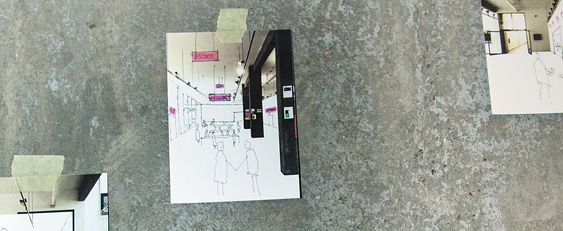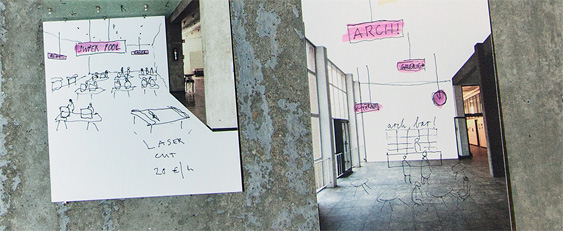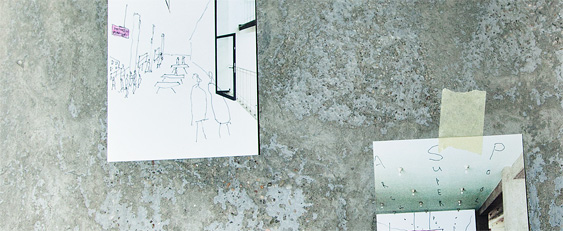History
In what style should we build (Heinrich Hübsch)
In the beginning there was: the Polytechnic School.
In the history of science, the University of Karlsruhe (Technical University), now KIT, deserves a pioneering role in several respects. It was founded as the first polytechnic school in Germany and thus not only established a new course of education, but also managed to maintain its position as a leading institution up to the present day. From the very beginning, the subject of architecture has played a leading role.
The Technical University owes its foundation to the initiative of the sovereign Grand Duke Ludwig, who established the "Polytechnic School" by decree in 1825. Karlsruhe's example was followed by Darmstadt (1826), Munich (1828), Dresden (1828) and Hanover (1831) with the establishment of corresponding educational institutions.
The model for the Karlsruhe Polytechnic School was the Ecole Polytechnique in Paris, founded in 1794/95, the first college for engineers and architects with a scientific and technical curriculum. The focus of the polytechnic teaching model was on combining theory and practice. Knowledge was converted into direct benefits by means of concrete tasks. A step-by-step problem-solving procedure served as a didactic tool, i.e. a methodical procedure, a set of instruments relevant to practice, which could also be applied to cases of a different nature.
The Karlsruhe Polytechnic School emerged from the amalgamation of various already existing educational institutions. These included Gottfried Tulla's (1770-1828) engineering school, founded in 1807, and the private construction school run by Friedrich Weinbrenner (1766-1826) since 1800. Weinbrenner already realized polytechnical goals in his building school. They consisted in the combination of theory and practice, project work in the form of exercises, and the grouping of students into learning communities.
These elements of the curriculum were adopted in the programme of the newly founded school. After a three-year basic education with a strong mathematical orientation, specialization followed. Either the study of engineering at Tulla or the study of architecture at the Bauschule were taken up, both of which were still maintained as independent institutions. At this time, the Polytechnic School was still a preliminary stage for prospective engineers and architects, in which they received general education and basic knowledge before acquiring specialized knowledge in the affiliated technical schools.
After a few years of experience, the Grand Ducal Ministry of the Interior commissioned the State Councillor Friedrich Nebenius to reorganise the Polytechnic School in 1832. Basic education was now divided into two classes, with technical drawing as the theoretical focus alongside mathematics and physics.
This "Karlsruhe model" did not remain without impact on other institutions; in particular, the Swiss Federal Institute of Technology in Zurich, founded in 1855, followed suit. In the course of the next decades it underwent further modifications, but above all extensions. In 1865, the prerequisites for a university constitution for the Polytechnic School and equal status with the universities were met, even though the official designation as "Technische Hochschule" in Karlsruhe did not take place until 1855 and as a university until 1967.
Thehistory of architecture in Germany could be written using the Technical College in Karlsruhe as an example. This is certainly also true for other educational institutions, but especially in the 19th century and until the end of the Empire, Karlsruhe maintained a leading position.
Standards were already set by the building activity in the city, for in Karlsruhe a centre of German classicism was established from the time around 1800 with the Baden Oberbaudirektor Friedrich Weinbrenner (1766-1826) established a center of German classicism. As an advisor to the commission that dealt with the formation of the Polytechnic School in 1808, Weinbrenner, a native of Karlsruhe, was one of the founding fathers, although he did not explicitly teach at the new educational institution and died only a year after its opening.
And yet Weinbrenner's Bauschule marked the beginning of the link between teachers and a state office, which was continued at the Karlsruhe Polytechnic and which ensured that students not only had practical experience, but also an insight into later work within the building administration. Initially, the lyceum built by Weinbrenner on Marktplatz served as the seat of the polytechnic school. He therefore also deserves the honour of being the first architect to have designed a building for the Karlsruhe Polytechnic, even if it was not originally intended for the Polytechnic. Weinbrenner thus stands at the beginning of a Karlsruhe tradition that lasted until the 1920s, in which the commissioning of architects teaching at the school with institute buildings was understood as a programmatic representation of the university to the outside world.
Weinbrenner's successor in office and at the same time teacher at the Polytechnic was his pupil Heinrich Hübsch (1795-1863). As early as 1828, he published the influential paper "In welchem Style sollen wir bauen?" ("In what style should we build?"), in which he clearly turned away from classicism. Hübsch's concept of style is not defined historically, but technologically. One of the first buildings Hübsch constructed in the round-arch style was the new Polytechnic School building on Kaiserstraße, planned and occupied between 1829-1833. Subsequently extended several times, it now serves the KIT administration.
The period of stylistic pluralism known as Historicism found expression in authoritative architects at the Karlsruhe Polytechnic. The most important of these were Josef Durm (1837-1919), the builder of the Aulabau (1892-1899) and the Botanical Institute (1895-1897), and Carl Schäfer (1844-1908). Both architects distinguished themselves by writing manuals with scientific pretensions about the epochs they considered exemplary.
It was not until 1907 that the Karlsruhe-born Hermann Billing (1867-1946), who had studied for a few semesters at the Technical University in his home town, was engaged as a representative of the Art Nouveau style. The multi-talented Billing, who devoted himself not only to architecture but also to painting, sculpture and interior design, integrated a so-called studio course into the teaching programme from 1919 onwards. Here a group of students worked together on a theme for a semester, each being assigned a task according to his or her inclinations and abilities. The result was a fully detailed building - created in a way that corresponded to office practice and was thus intended to prepare students for the real world.
In the same year as Billing, the young architect Friedrich Ostendorf (1871-1915) was called to Karlsruhe as a professor to succeed his teacher Schäfer.
Through his "Six Books on Building", which claimed to be nothing less than a "Theory of Architectural Design", Ostendorf was regarded by the young generation as a beacon of hope for a generally valid, timelessly classical style based on craftsmanship.
As was the case at most technical universities, modernism was only tentatively established in Karlsruhe during the Weimar Republic. With the Ostendorf student Hermann Alker (1885-1967), builder of the Karlsruhe University Stadium (1927-1930), but above all with Otto Ernst Schweizer (1890-1965), appointed in 1930, who also distinguished himself in the field of stadium construction, New Building was at least represented by two teachers.
After the Second World War, the Technical University of Karlsruhe moved into Egon Eiermann (1904-1970), the Technical University of Karlsruhe took a clear stance towards modernity and at the same time a clear counter-position to the conservative Stuttgart School.
Already belonging to the second generation of Modernism, Eiermann, a student of Poelzig, was still constructing uncompromising buildings in the 1930s; one of his most famous works during his time in Karlsruhe was the reconstruction of the Kaiser Wilhelm Memorial Church in Berlin. Without a doubt, Egon Eiermann must be considered the most influential teacher in the 20th century at the Department of Architecture at Karlsruhe University.
Text: Annemarie Jaeggi
Architecture at the University of Karlsruhe -
Department of Architecture - Research and Teaching, 1999
Ernst Wasmuth Publishing House, Tübingen/Berlin
abridged 2010
Illustrations:
Max Kaske and Maximilian Goes
"Public Spheres - 20.40. Places and Potentials"
Free impromptu, winter semester 2014/15
Department of Architectural Theory
Prof. Georg Vrachliotis



